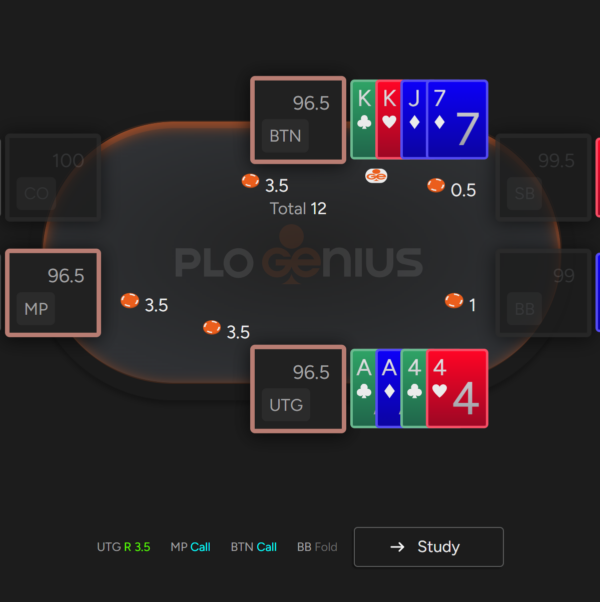C-betting — or continuation betting — is one of the most important weapons in a Pot-Limit Omaha player’s arsenal. When you're the preflop raiser and have position, the ability to apply pressure postflop with a well-timed c-bet can generate fold equity, build pots with strong hands, and help deny equity to your opponent’s range. But unlike in No-Limit Hold’em, where ranges are narrower and equities are more polarized, PLO demands a much more selective and nuanced c-betting approach.
In PLO, equities run close, and the presence of four hole cards means draws, redraws, and blockers are everywhere. This makes blind aggression a losing strategy. Instead, strong PLO players adapt their c-betting based on board texture, the distribution of nut and near-nut hands, and their hand’s ability to improve or block key parts of the opponent’s range.
This guide focuses on c-betting strategy in Single Raised Pots (SRPs) when you are in position as the preflop aggressor. We've broken the strategy down into four main board types — unpaired, straightening, monotone, and paired — and for each one, you'll find:
-
Recommended c-bet sizes
-
Optimal c-bet frequencies
-
Example boards to study
-
The types of hands you should typically bet
-
Hands that should often be checked back
Below each table are extended hand examples to help you recognize these situations in real time. Whether you're betting for value, applying pressure with nut blockers, or holding off to realize equity, the key is understanding when your hand benefits from betting and when it doesn't.
Use these charts and examples as a foundation for your postflop IP strategy — and always remember that the most profitable PLO decisions come from leveraging position, selecting the right boards to attack, and thinking one street ahead.
📊 PLO IP C-Bet Strategy – Single Raised Pots
| Board Type | Example Boards | C-Bet Size | C-Bet Frequency | Hands To C-Bet | Hands To Check |
|---|---|---|---|---|---|
| Unpaired |
Q♠-J♥-6♦ K♥-6♣-5♠ A♦-8♣-3♥ 10♠-6♣-2♥ |
75% Pot | ~55% |
Nut overpairs Combo draws Strong blockers Overcard + BDFD |
Medium pairs Weak top pair Low equity floats No backdoors |
| Straightening |
10♠-9♣-8♦ 8♠-7♣-6♦ J♥-10♦-9♣ 9♦-7♣-5♠ |
50% Pot | ~30–40% |
Nut blockers (A-K-Q-T) Top pair + redraws Strong two pair with straight redraws |
Bottom 2 Weak wrap with no BDFD One-pair hands with no equity |
| Monotone |
A♠-Q♠-5♠ J♦-9♦-4♦ K♣-8♣-2♣ |
50% Pot | ~30–50% |
Nut flushes Strong top pair with nut blocker A♣ blockers with redraws |
Weak flushes Hands with no flush draw Second-pair hands |
| Paired |
9♠-9♦-2♣ 7♠-3♠-3♦ Q♣-Q♦-5♥ |
33% Pot | ~70–95% |
Trips Overpairs with redraws Blockers to full house |
No equity Low gutshots Airballs |
✅ Extended Example Hands To C-Bet
| Hand | Board | Reason |
|---|---|---|
| A♠9♠K♣K♦ | K♥-6♣-5♠ | Top set, nut blockers |
| Q♥Q♦2♣2♦ | J♠-10♥-8♣ | Blocker c-bet, no SDV |
| A♠J♥10♠6♦ | Q♠-9♠-3♠ | Nut flush draw + overcard |
| A♦Q♣10♥9♣ | K♦-J♥-8♠ | Open-ender + nut straight blockers |
| J♥10♥6♠4♣ | J♥-8♦-3♠ | Top pair + BDFD |
❌ Extended Example Hands To Check
| Hand | Board | Reason |
|---|---|---|
| K♦Q♥7♣6♦ | J♠-10♣-8♠ | Weak pair, no redraw |
| 8♠7♦6♠5♦ | Q♥-10♦-7♣ | Low bottom pair, vulnerable |
| A♦J♠10♠8♥ | 5♣-4♦-2♠ | No equity vs BB range |
| 9♣6♥4♦2♥ | J♦-10♦-3♥ | Airball with zero blockers |
| 10♠8♦5♣3♥ | K♣-K♥-6♠ | No pair, no draw, dead spot |














